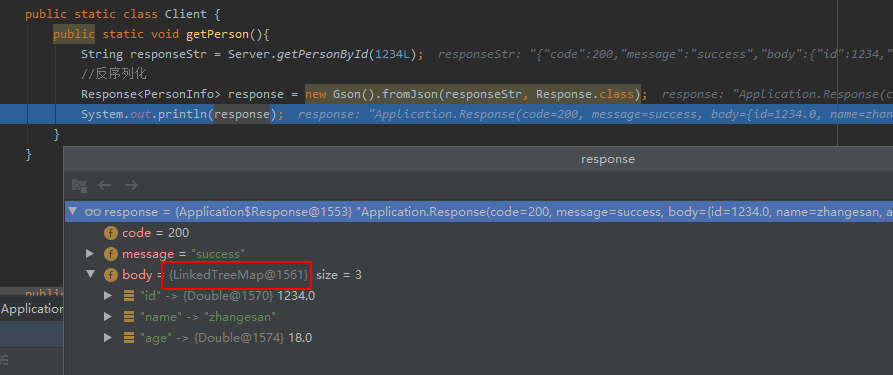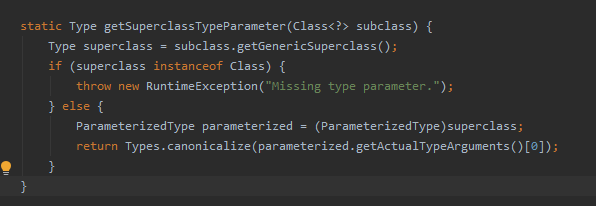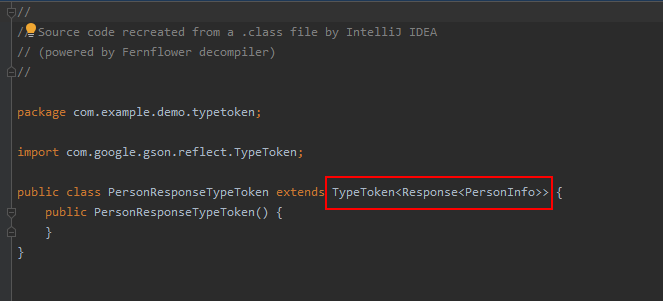Gson的TypeToken与泛型擦除
原创:扣钉日记(微信公众号ID:codelogs),欢迎分享,转载请保留出处。
问题
在Java的json框架中,Gson是使用得比较广泛的一个,其Gson类提供了toJson()与fromJson()方法,分别用来序列化与反序列化。
json序列化用得最多的场景是在调用外部服务接口时,大致如下:
@Data
@AllArgsConstructor
public class Response<T>{
int code;
String message;
T body;
}
@Data
@AllArgsConstructor
public class PersonInfo{
long id;
String name;
int age;
}
/**
* 服务端
*/
public class Server {
public static String getPersonById(Long id){
PersonInfo personInfo = new PersonInfo(1234L, "zhangesan", 18);
Response<PersonInfo> response = new Response<>(200, "success", personInfo);
//序列化
return new Gson().toJson(response);
}
}
/**
* 客户端
*/
public class Client {
public static void getPerson(){
String responseStr = Server.getPersonById(1234L);
//反序列化
Response<PersonInfo> response = new Gson().fromJson(responseStr, new TypeToken<Response<PersonInfo>>(){}.getType());
System.out.println(response);
}
}
由于大多数接口设计中,都会有统一的响应码结构,因此大多项目都会像上面一样,设计一个通用Response类来对应这种统一响应码结构,是很常见的情况。
但会发现,在反序列化过程中,传入目标类型时,使用了一段很奇怪的代码,即new TypeToken<Response<PersonInfo>>(){}.getType(),那它是什么?为啥要使用它?
TypeToken是什么
为什么要使用TypeToken呢?我们直接使用Response<PersonInfo>.class行不行?如下:

可以发现,java并不允许这么使用!
那传Response.class呢?如下:

可以发现,代码能跑起来,但是Body变成了LinkedHashMap类型,这是因为传给gson的类型是Response.class,gson并不知道body属性是什么类型,那它只能使用LinkedHashMap这个默认的json对象类型了。
这就是TypeToken由来的原因,对于带泛型的类,使用TypeToken才能得到准确的类型信息,那TypeToken是怎么取到准确的类型的呢?
首先,new TypeToken<Response<PersonInfo>>(){}.getType()实际上是定义了一个匿名内部类的对象,然后调用了这个对象的getType()方法。
看看getType()的实现,如下:

逻辑也比较简单,先通过getGenericSuperclass()获取了此对象的父类,即TypeToken<Response<PersonInfo>>,然后又通过getActualTypeArguments()[0]获取了实际类型参数,即Response<PersonInfo>。
额,逻辑看起来说得通,但不是说Java泛型会擦除吗?这里不会擦除?
从所周知,java泛型擦除发生在编译期,ok,那我模拟上面的原理,写个空类继承TypeToken<Response<PersonInfo>>,然后编译这个类之后再反编译一下,看类型到底擦除没!
public class PersonResponseTypeToken extends TypeToken<Response<PersonInfo>> {
}
反编译结果如下:

也就是说,被继承的父类上的泛型是不擦除的。
其它使用场景
有时为了编程的方便,经常会有框架将远程调用接口化,类似下面这样:
public class RemoteUtil {
private static final ConcurrentMap<Class, Object> REMOTE_CACHE = new ConcurrentHashMap<>();
public static <T> T get(Class<T> clazz) {
return clazz.cast(REMOTE_CACHE.computeIfAbsent(clazz, RemoteUtil::getProxyInstance));
}
private static Object getProxyInstance(Class clazz) {
return Proxy.newProxyInstance(ClassLoader.getSystemClassLoader(), new Class[]{clazz}, (proxy, method, args) -> {
Gson gson = new Gson();
String path = method.getAnnotation(RequestMapping.class).path()[0];
HttpURLConnection conn = null;
try {
conn = (HttpURLConnection) new URL("http://localhost:8080/" + path).openConnection();
conn.setRequestMethod("POST");
conn.setDoOutput(true);
conn.setDoInput(true);
conn.connect();
//设置请求数据
JsonObject requestBody = new JsonObject();
try (Writer out = new OutputStreamWriter(conn.getOutputStream(), StandardCharsets.UTF_8)) {
int i = 0;
for (Parameter parameter : method.getParameters()) {
String name = parameter.getAnnotation(RequestParam.class).name();
requestBody.add(name, gson.toJsonTree(args[i]));
i++;
}
out.write(requestBody.toString());
}
//获取响应数据
if (conn.getResponseCode() != HttpURLConnection.HTTP_OK) {
throw new RuntimeException("远程调用发生异常:url:" + conn.getURL() + ", requestBody:" + requestBody);
}
String responseStr = IOUtils.toString(conn.getInputStream(), StandardCharsets.UTF_8);
//响应结果反序列化为具体对象
return gson.fromJson(responseStr, method.getReturnType());
} finally {
if (conn != null) {
conn.disconnect();
}
}
});
}
}
public interface PersonApi {
@RequestMapping(path = "/person")
Response<PersonInfo> getPersonById(@RequestParam(name = "id") Long id);
}
public class Client {
public static void getPerson() {
Response<PersonInfo> response = RemoteUtil.get(PersonApi.class).getPersonById(1234L);
System.out.println(response.getBody());
}
}
这样做的好处是,开发人员不必再关心如何发远程请求了,只需要定义与调用接口即可。
但上面调用过程中会有一个问题,就是获取的response对象中body属性是LinkedHashMap,原因是gson反序列化时是通过method.getReturnType()来获取返回类型的,而返回类型中的泛型会被擦除掉。
要解决这个问题也很简单,和上面TypeToken一样的道理,定义一个空类PersonResponse来继承Response<PersonInfo>,然后将返回类型定义为PersonResponse,如下:
public class PersonResponse extends Response<PersonInfo> {
}
public interface PersonApi {
@RequestMapping(path = "/person")
PersonResponse getPersonById(@RequestParam(name = "id") Long id);
}
然后你就会发现,gson可以正确识别到body属性的类型了。
往期内容
密码学入门
接口偶尔超时,竟又是JVM停顿的锅!
耗时几个月,终于找到了JVM停顿十几秒的原因
mysql的timestamp会存在时区问题?
真正理解可重复读事务隔离级别
字符编码解惑

